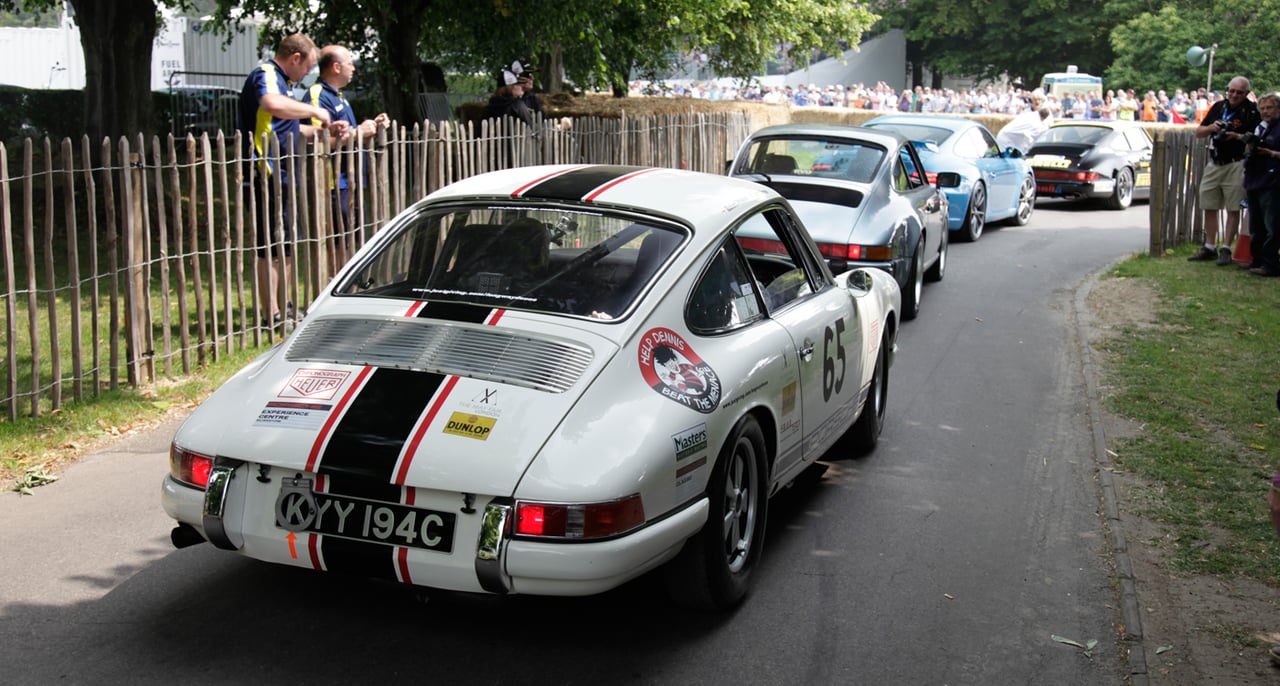Kings of the Hill: The best of the Goodwood Festival of Speed 2013
Porsche 911 – 50 years at full throttle


Fear not. While the surrounding countryside seems lifted straight from a BBC HD nature documentary, the latest technological masterpiece from Stuttgart is the kindest yet to the environment. And from the driving seat, the lush green trees, the dark, glittering lakes and circling birds of prey pass by undisturbed and in almost total silence.
After a speech by Lord March likening the "beauty and function" of Gerry Judah's 22-tonne masterpiece to the car it commemorates, a thunderous firework display penetrated the crisp night air of the Goodwood estate. Despite the meticulous planning, the ceremony's impact was soon outdone - by Richard Attwood pulling up outside the house in his 1970 Le Mans-winning 917 (appropriately sporting a tuxedo...), only to be greeted by long-time comrade Hans Herrmann. It's moments like this that add weight to the claims of Goodwood being the pinnacle of the world's automotive gatherings.
Toronto is Canada’s most populous city, and currently has more ‘work in progress’ skyscrapers than New York, its opposite number in America. From deluxe hotels to half-complete towers and ramshackle backstreets, the city's landscape is almost as diverse as the people who inhabit it – and what better place to settle into, ready for a private tour, than the back seat of a classic S-Class? Browse the gallery above and join us in First Class.
Photos: Jan Richter
Mercedes has always claimed that the S-Class is the best car in the world, and who are we to take issue with that? In 1972, the W116 was born relatively easily, into a world distinctly lacking in luxury saloon cars, vastly different from today’s intensely competitive market.
Named ‘Project 7’ – a reference to Jaguar’s seven Le Mans victories – the F-type has been given a variety of styling addenda, including a reinterpretation of the D-type’s characteristic offset tailfin, and is finished in Flag Blue - the very same shade worn by the Ecurie Ecosse Le Mans-winning cars of 1956 and 1957. Gone is the F-type’s roof mechanism; a roll-hoop is incorporated into the new fin, while the passenger seat is removed, replaced by a dock for the bespoke helmet.
It’s been designed by two brothers, Guillermo and Iker Echeverria, whose father built and successfully raced his own cars for 30 years. According to Iker, the new car “has been developed by enthusiasts for enthusiasts”, and it certainly boasts astounding performance. Thanks to a dry weight of 695kg, plus a 2-litre, 285bhp turbocharged Ford EcoBoost engine, the Vühl – intended for both road and track use – belts to 62mph in just 3.7 seconds and promises a top speed of more than 150mph.
Silver for Germany, white and blue for the USA, green for Great Britain and yellow for Belgium – different colours, and all seen on winners at racetracks worldwide. But there’s always something about a red car – and it does not have to be Italian – that gives it extra appeal.
Ferrari and Maserati dominated racing in the 1950s and early 1960s, yet a red Lagonda won at Le Mans in 1935, a red Ford Mk IV at the same race in 1967 and, pre-War, works Aston Martin Ulsters were painted in the colours of the home country of team principle Bertelli.
Audi built 200 road-going Sport Quattros to homologate its Group B rally car in the 80s, though there’s much debate as to whether that many were actually delivered.
The Sport Quattro looks awkward from whichever angle you look at it...